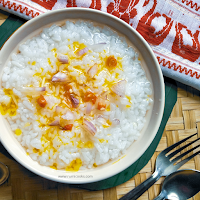Poita Bhat | Paani Bhat | Watered Rice : The smart solution for leftover rice (with instant poita bhat recipe)
Assamese call it poita bhat, Bengalis call ponta bhat, pakhala in Odisha, geel bhat in Bihar, pazhankanji in Kerela and palaya sadam or palayathu or neeragaram in South India. Known by different names in different regions in the Indian subcontinent, fermented rice is a dish consumed by different communities of India in their own style since ancient times. The leftover cooked rice is soaked in water for overnight for fermentation. The next day it is served in breakfast.
Traditionally Assamese poita bhat is served with mashed potato (aloo pitika) or mashed grilled fish (pura masor pitika).The fermented rice is served in bell metal bowl and little raw mustard oil, chopped chillies, chopped onions, few drops of lemon juice and pinch of salt is added to it before serving. As water is added to the cooked rice, we also call it paani bhat. Paani means water and bhat means rice which means watered rice.
Poita bhat was known as "the poor man's breakfast" in ancient times. In those days the poor farmers who used to go farming early in the morning get no time to cook breakfast. So they prepare fermented rice previous night from leftover cooked rice and consume it next day in the morning. Poita bhat is still very popular in rural areas. Now a days, not only in rural areas, it is getting popular in urban areas also as we often see poita bhat pics on social media posted by foodies and food enthusiasts as people are getting more concern about their roots.
Poita bhat is mostly consumed during summer. As the dish is cool and wet, it keeps the body cool. Beside keeping the body cool, poita bhat has some nutritional value too. In a study conducted by Assam Agricultural University it is revealed that the quantity of iron content in cooked rice increases after fermenting for 12 hours. (source)
Poita bhat is fermented watered rice soaked in water for 12 hours. But we can also make instant paani bhat or instant watered rice. No need to soak rice overnight. It may be little less in nutritional value compared to overnight soaked rice but it is a perfect solution for food wastage. Making instant watered rice not only can save food wastage but also can save time too. Below is the recipe of instant watered rice.
Instant Poita Bhat | lnstant Paani Bhat | instant Watered Rice :
📎Course : Breakfast
- 1 bowl of cooked rice
- 2 cups of water
- 1 chopped onion
- 1 chopped chilli (green or red)
- 1/2 tbsp lemon juice
- 1/2 tbsp mustard oil
- salt to taste
METHOD:
- In a large bowl take cooked rice. The rice must be cool. Preferably use leftover rice.
- Add 2 cups of water or as required so that the whole rice soaked well.
- Add chopped onions, chillies, mustard oil, lemon juice and salt.
- Mix everything well and served with mashed potato (aloo pitika), pickle or with any dry sabji or whatever you like.


Comments
Post a Comment